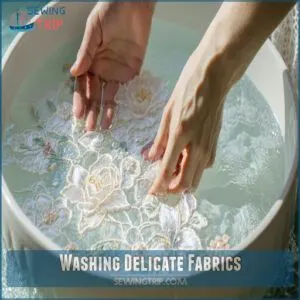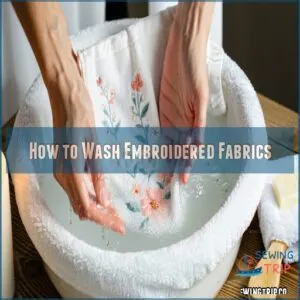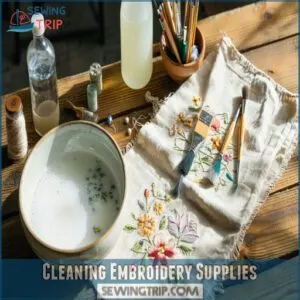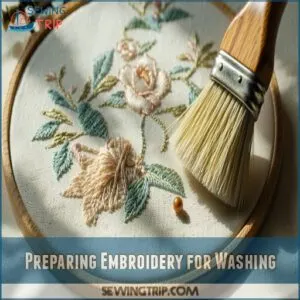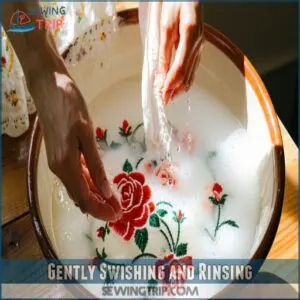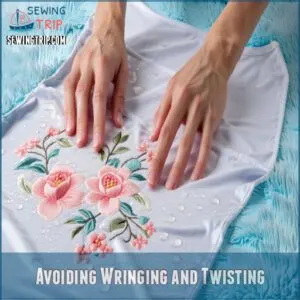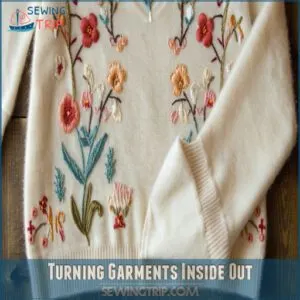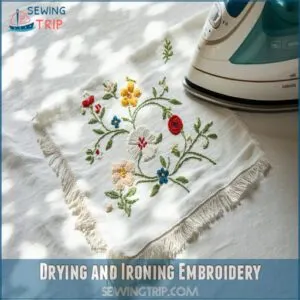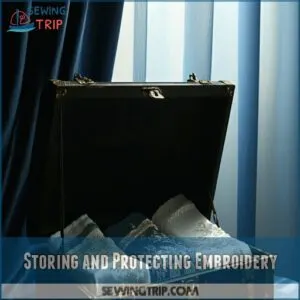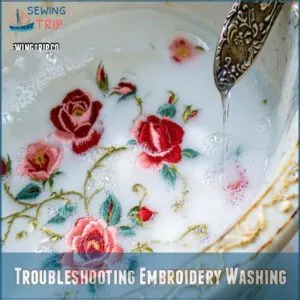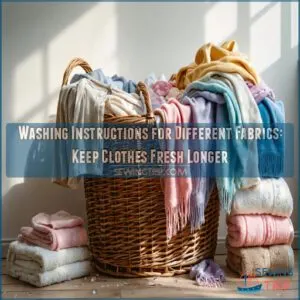This site is supported by our readers. We may earn a commission, at no cost to you, if you purchase through links.
 When washing delicate embroidered fabrics, treat them like a treasured heirloom. Start by checking for loose threads and testing colorfastness on a hidden spot with water.
When washing delicate embroidered fabrics, treat them like a treasured heirloom. Start by checking for loose threads and testing colorfastness on a hidden spot with water.
Use lukewarm water and a mild detergent—just a small splash is enough. Submerge the fabric, gently swishing it around with your hands for a few minutes.
Rinse with cool water until it’s clear, then lay the fabric flat on a towel to air dry—no wringing or twisting, as that can damage the embroidery.
If you’re in a pinch, use a mesh bag and the washing machine’s gentle cycle, but hand washing is always safer.
Table Of Contents
- Key Takeaways
- Washing Delicate Fabrics
- How to Wash Embroidered Fabrics
- Cleaning Embroidery Supplies
- Preparing Embroidery for Washing
- Hand Washing Embroidered Clothes
- Machine Washing Embroidered Items
- Drying and Ironing Embroidery
- Storing and Protecting Embroidery
- Troubleshooting Embroidery Washing
- Frequently Asked Questions (FAQs)
- Conclusion
Key Takeaways
- Hand wash embroidered fabrics in lukewarm water with mild detergent, gently swishing without scrubbing, and rinse with cool water.
- Always avoid wringing, twisting, bleach, or fabric softeners to protect threads and prevent damage.
- Use mesh bags and delicate cycles with cold water if machine washing, but hand washing is safer.
- Lay fabrics flat on towels to air dry, avoiding direct sunlight and heat to keep colors and stitching intact.
Washing Delicate Fabrics
You’ll discover that washing your delicate embroidered fabrics doesn’t have to be a nerve-wracking experience when you follow the right steps.
Whether you’re cleaning a cherished family heirloom or your latest needlework creation, these expert techniques will help you keep your treasured pieces looking their best without damaging the intricate stitching.
Hand Washing Techniques
Anyone can master hand washing embroidery with care and patience.
Start by inspecting your fabric for loose threads or damage.
Fill a basin with lukewarm water – not hot or cold – and add a gentle soap designed for delicates.
For more detailed instructions, review these tips for handling delicates.
Submerge your piece and use soft, circular motions for gentle agitation. Focus on thread protection by avoiding harsh scrubbing. You’ll want to handle the fabric like you’re washing delicate silk.
Machine Washing Precautions
When machine washing embroidery, always prioritize fabric protection.
Turn garments inside out to shield designs, then place them in mesh bags for added safety.
Use gentle cycles with cold water to prevent damage and color bleeding.
Stick to delicate detergents, avoiding bleach or fabric softeners.
Follow embroidery washing instructions carefully, and never overload the machine.
Washing embroidered clothes this way guarantees a gentle embroidery wash without compromising delicate embroidery care.
Choosing Mild Detergents
For delicate embroidery care, pick a mild detergent with a gentle formula to protect fabric safety.
Avoid harsh chemicals like bleach; instead, choose eco-friendly options or soap alternatives with a neutral pH.
Liquid detergents work well for embroidery detergent needs, as they’re versatile and easy to apply.
Consider pH balanced detergents like Dropps.
Stick to fragrance-free options to prevent damage, ensuring your gentle cleaning routine keeps your treasures looking their best, with a focus on delicate embroidery care.
How to Wash Embroidered Fabrics
Washing embroidered fabrics takes patience and care. Start by checking for dust or lint—use a soft brush to gently clean the surface. Always test for colorfastness on a hidden spot to avoid surprises.
For hand wash embroidery, fill a basin with lukewarm water and mild detergent. Swish gently without scrubbing. Rinse thoroughly in cool water. Be sure to review expert embroidery washing tips before you begin.
- Avoid wringing to protect threads.
- Lay flat on a towel to dry.
- Keep embroidered fabric cleaning safe by skipping bleach and fabric softeners.
Cleaning Embroidery Supplies
Keeping your embroidery supplies clean is just as important as washing the fabrics themselves.
Using soft brushes, mild detergents, and a little white vinegar make sure your tools stay in top shape for every project.
Soft Brushes and Lint Rollers
Soft brushes and lint rollers are delicate tools essential for gentle cleaning.
Use a brush with soft bristles to remove dust from embroidered fabrics without damaging threads.
For lint removal, a lint roller works wonders, especially on intricate designs.
You can find soft brush embroidery supplies to aid in this process.
Always brush gently, following the fabric’s weave.
Spot cleaning with a soft brush dipped in gentle detergent can help tackle stubborn areas, ensuring your embroidery stays pristine and requires minimal delicate care.
Mild Detergents and Soap
Using gentle cleansers like mild detergent or soap is essential for fabric safety when cleaning delicate fabrics.
Choose detergent options labeled for delicates or hand washing, avoiding harsh chemicals. Mild formulas protect embroidery threads from damage.
Liquid soap types dissolve better than powders, guaranteeing gentle cleaning.
Always dilute soap in lukewarm water before use, and test on an inconspicuous area to ensure compatibility.
This ensures the delicate fabrics are cleaned safely.
White Vinegar and Clean Towels
White vinegar works wonders for hand washing embroidery.
Mix a splash into lukewarm water to enhance stain removal and fabric softening. Pair it with clean towels for gentle cleaning—choose lint-free ones to avoid snags.
After rinsing with mild detergent, use a towel to press out water without twisting.
Vinegar benefits delicate fabrics by preserving color and texture, making it a must-have for your care routine, as it enhances stain removal and helps with fabric softening.
Preparing Embroidery for Washing
Before washing your embroidery, you’ll need to remove dust and lint with a soft brush or lint roller.
Then, check the fabric and thread type to confirm you’re using the right cleaning method.
Removing Dust and Lint
Before hand washing, focus on dust removal and lint cleaning to protect delicate fabrics. A little preparation goes a long way in keeping those stitches safe.
Here’s how to get started:
- Use a soft brush to gently sweep dust and lint from the surface. Avoid vigorous rubbing.
- Grab a lint roller for stubborn bits, working carefully to avoid snagging threads.
- Lay the fabric flat on a clean surface to prevent shifting while cleaning.
- Check seams and corners, as dust often hides there.
- Inspect under good light, ensuring no debris remains before moving on to spot cleaning or washing.
Regular maintenance like sewing machine cleaning helps prevent damage to embroidery.
Identifying Fabric and Thread Type
Knowing your fabric type and thread type is like choosing the right tools for the job—it’s essential.
Delicate fabrics, like silk or linen, need gentle care, while cotton embroidery is a bit tougher.
For thread identification, check if it’s silky rayon, sturdy polyester, or textured wool. Material testing helps prevent surprises like color bleeding.
If unsure, test colorfastness on a hidden spot first. Pay attention to fiber analysis to avoid damaging embroidered fabrics during washing.
Here’s a quick guide:
| Fabric Type | Thread Type | Texture | Strength | Care Tips |
|---|---|---|---|---|
| Cotton | Cotton | Soft | Durable | Mild detergent, cold water |
| Silk | Silk | Smooth | Fragile | Hand wash, air dry flat |
| Linen | Linen | Textured | Strong | Low heat ironing |
| Wool | Wool | Cozy | Medium | Gentle wash, avoid heat |
| Rayon | Rayon | Shiny | Delicate | Test for colorfastness |
Hand Washing Embroidered Clothes
Hand washing embroidered clothes keeps them safe from damage while preserving their beauty.
You’ll need lukewarm water, a gentle touch, and patience to clean these delicate treasures the right way, with patience being crucial.
Filling Basin With Lukewarm Water
Start by choosing a clean basin appropriate for hand washing. Fill it with lukewarm water—neither too hot nor too cold, as delicate fabrics require gentle care.
Add a small amount of mild detergent, ensuring it dissolves evenly. Stir gently with your hand for proper basin preparation.
Now, submerge your embroidered garment slowly, allowing gentle submersion to preserve its detail. Prioritize delicate handling throughout this step.
Gently Swishing and Rinsing
After filling the basin with lukewarm water and a mild detergent, gently agitate the garment. Treat the fabric like it’s fragile—don’t scrub or twist.
Instead, follow these steps:
- Submerge and swish the item slowly.
- Use your fingertips to loosen dirt.
- Swap between light swirls and pauses.
- Check water temperature stays lukewarm.
- Drain and begin rinsing with cold water.
The key to this process is to be gentle and ensure the water stays lukewarm, using fingertips to loosen dirt, and handling the fabric with care to prevent damage.
Avoiding Wringing and Twisting
When washing embroidered clothes, resist the urge to wring or twist, as it stresses the fibers and risks embroidery damage.
Instead, gently press out water to maintain shape.
Proper fabric care prevents delicate washing mishaps.
| Method | Risk of Damage | Recommended Practice |
|---|---|---|
| Wringing | High | Avoid completely |
| Twisting | Fibers may weaken | Press gently, lay flat |
| Gentle Press | Minimal, if careful | Always use soft towels |
Keep it simple—pat excess water and let air drying do the rest, it is always best to press gently and avoid completely any action that may cause damage, such as wringing, to ensure the embroidery remains intact.
Machine Washing Embroidered Items
When machine washing embroidered items, you’ll need to take a few extra steps to keep them safe.
Turn the garment inside out, place it in a mesh laundry bag, and use a delicate cycle with cold water and mild detergent.
Turning Garments Inside Out
Before tossing your embroidered treasures into the wash, flip them inside out.
This simple step keeps your designs safe from snagging or fading.
Turning garments inside out reduces friction during cleaning, which is key for delicate handling.
It’s part of proper embroidered garment care, helping protect embroidery threads while preserving fabric safety.
Follow care instructions carefully to make sure your washing embroidered clothes routine doesn’t damage cherished pieces, ensuring the longevity of your embroidered treasures.
Using Mesh Bags and Gentle Cycles
Protecting hand-embroidered garments during machine washing is simple.
Use a mesh laundry bag to shield delicate fabrics from friction. Turn items inside out, place them in the bag, and select a gentle cycle with cold water.
This delicate wash option prevents damage. The mesh bag acts like a safety net, reducing snags, while cold water maintains embroidery color and structure.
It’s fabric protection made easy!
Avoiding Bleach and Fabric Softeners
Cold water and a gentle cycle work wonders for washing delicate fabrics, but steer clear of bleach and fabric softeners.
These harsh products can weaken threads and cause color bleeding, harming your embroidery.
Stick to gentle cleansers designed for delicates, which provide Fabric Protection and Color Preservation.
Bleach alternatives, like oxygen bleach, are safer options if needed.
Prioritize a delicate wash cycle for long-lasting, beautiful results, using methods that ensure delicate care.
Drying and Ironing Embroidery
After washing, always air dry your embroidery flat on clean towels, keeping it away from heat or sunlight to prevent distortion or fading.
When ironing, use a low heat setting, place a pressing cloth over the embroidery, and work carefully to protect the delicate stitches, ensuring you handle the embroidery with care to avoid damaging the delicate stitches.
Air Drying and Shaping
After the gentle wash, lay your embroidery flat on a clean, dry towel or drying rack to air dry completely.
Avoid hanging, as this may distort stitching. For proper air shaping, use delicate handling—press gently to reshape the fabric if needed.
For more detailed care, learn how to iron embroidery projects correctly.
Experiment with gentle folding to maintain form, and incorporate reshaping techniques to avoid wrinkles, and never use heat or direct sunlight during this process, ensuring the embroidery remains in good condition with proper care.
Ironing on Low Heat Settings
For embroidery care, low heat ironing is essential to prevent damage.
Always set your iron to the lowest heat setting suitable for delicate fabrics. To avoid scorching, adjust heat settings carefully and make sure the embroidery is fully dry before starting.
Iron embroidered clothes inside out, gently moving the iron over the fabric. This technique protects the embroidery while maintaining its shape after a cold water wash or delicate wash cycle, which is crucial for delicate fabrics.
Using Pressing Cloths and Protective Measures
Don’t ruin your embroidery while ironing—use a pressing cloth to preserve embroidery! This extra layer provides fabric protection from direct heat.
You can find a variety of pressing cloth embroidery products online.
Follow these ironing tips:
- Lay a clean pressing cloth over the embroidery.
- Set your iron to low or silk settings.
- Gently press the cloth, avoiding harsh movements.
- Let it cool to prevent distortions.
Delicate handling keeps your silk embroidery flawless, ensuring it remains in good condition with the right embroidery products.
Storing and Protecting Embroidery
When storing embroidered fabrics, fold them carefully with acid-free tissue paper between the layers to prevent creases and snagging.
Keep them in a cool, dry space, away from direct sunlight and moisture, to maintain their color and quality.
Folding and Hanging Techniques
Properly folding and hanging embroidered clothes guarantees long-lasting preservation.
For folded storage, place tissue between layers to avoid creases in delicate fabrics like silk embroidery.
When hanging, use padded hangers to maintain garment shape and prevent stretching.
Always air dry embroidery fully before storing, and never fold when damp, to protect embroidery designs and keep your hard work looking fresh and beautiful for years to come, ensuring long-lasting preservation.
Using Tissue Paper and Padded Hangers
To protect embroidery and keep it in excellent shape, use tissue wrapping and padded protection.
Place tissue paper between folds during gentle folding to prevent creases or thread pressure. Hang items on padded hangers for delicate handling, maintaining their shape.
This embroidery care guide guarantees fabric storage is safe and organized, supporting long-lasting beauty in your treasured pieces. Always handle gently to avoid embroidery damage, ensuring your pieces remain in excellent shape with delicate handling.
Avoiding Direct Sunlight and Moisture
Keep your embroidered treasures safe by avoiding sunlight damage and controlling moisture. Direct sunlight can cause color fading, while high humidity levels invite mold and mildew.
Follow these tips for proper fabric storage:
- Store embroidery in cool, dry places.
- Use breathable covers to protect embroidery.
- Keep items away from windows.
- Avoid damp spaces like basements.
- Monitor humidity levels with a dehumidifier.
Preserve your artistry with care, and remember to keep your treasures away from sunlight.
Troubleshooting Embroidery Washing
When embroidery washing doesn’t go as planned, it’s important to know how to fix mistakes quickly and safely.
You’ll learn how to handle stains, prevent further damage, and recognize when professional help might be the best option.
Common Mistakes to Avoid
Sometimes skipping small details causes big problems.
Over washing can lead to fabric damage or thread breakage.
Always avoid vigorous rubbing or scrubbing, which increases shrinkage risks.
Color bleeding occurs if you skip spot testing or use harsh chemicals.
Machine washing embroidered items?
Use protective methods to maintain washing machine safety.
| Mistake | Risk | Solution |
|---|---|---|
| Over washing | Fabric damage | Wash sparingly, only when needed. |
| Skipping spot testing | Color bleeding | Test colorfastness in hidden areas. |
| Rubbing or scrubbing | Thread breakage, shrinkage | Use gentle cleaning techniques. |
Removing Stains and Spots
Stains can ruin embroidery fast, but quick action and the right stain removal techniques save the day.
Always spot clean gently to protect delicate fabric. Start by testing colorfastness on an unseen area to avoid surprises.
For effective embroidery stain removal:
- Blot stains instead of rubbing to prevent damage.
- Use mild detergents and lukewarm water for softer fabrics.
- Pre-treat tough spots with a vinegar-water mix.
Identifying Professional Cleaning Needs
Embroidery care demands attention, but some situations call for professional help.
If embroidery stain removal feels tricky, or fabrics like silk and wool are involved, Fabric Experts recommend professional cleaning.
For delicate fabrics, consider specialized stain removal guides.
Delicate care guarantees preservation, while professionals use advanced cleaning methods like dry cleaning embroidery.
Before deciding, do a colorfastness test to avoid damage.
For irreplaceable pieces, trusting experts will save you headaches and your embroidery’s charm.
Frequently Asked Questions (FAQs)
How to wash delicate embroidery?
Treat delicate embroidery like fine china—gently and carefully.
Hand wash in lukewarm water with mild detergent, rinse thoroughly, and lay flat on towels to air dry.
Protect stitches by avoiding wringing, scrubbing, or direct heat.
Can you put embroidered clothes in the washing machine?
You can machine-wash embroidered clothes, but take precautions.
Turn them inside out, use a mesh bag, choose a delicate cycle, cold water, and mild detergent.
Avoid bleach or fabric softeners, and air-dry flat for safety.
Will embroidery come undone in the wash?
Treat embroidery like a secret recipe—it needs care to stay intact.
Washing gently, whether by hand or in a mesh bag on a delicate cycle, prevents thread unraveling.
Avoid hot water, heavy cycles, or harsh detergents, as these can cause thread unraveling.
How do you make embroidery last in the wash?
Handle embroidery with care by turning items inside out, washing on a gentle cycle with cold water, and using a mesh bag.
Stick to mild detergent, avoid bleach or softeners, and let it air dry flat, these are key steps to preserve the embroidery.
Can embroidered fabrics be treated for odors?
You can remove odors by soaking the fabric in lukewarm water with a splash of white vinegar.
Let it sit for 15 minutes, rinse gently, and air dry flat, away from direct sunlight.
How to remove mold from embroidered fabrics?
When life gives your embroidery a damp hug, dab a vinegar-water mix on moldy spots.
Hand wash gently in cold water with mild detergent, rinse well.
Lay flat, air dry, and avoid direct sunlight.
Are vintage embroidery pieces safe for washing?
Vintage embroidery needs extra care during washing.
Stick to hand washing using lukewarm water and mild detergent. Always test colorfastness first.
Avoid scrubbing or wringing, and air dry flat. When in doubt, consult a professional.
Does embroidery shrink after repeated washing?
Embroidery can shrink slightly after repeated washing, especially if you use hot water or tumble dry.
Stick to cold water, gentle detergents, and air drying to keep the embroidery’s shape and prevent distortion over time, this is a key concept to prevent distortion.
How to fix embroidery threads that fray?
Think of fraying threads as unruly vines.
Trim them gently with sharp scissors, then secure loose ends by threading a needle and stitching them back.
Use clear fabric glue sparingly for extra strength, if needed.
Conclusion
Imagine an embroidered quilt, passed down through generations, holding memories in every stitch.
That’s how you should care for delicate embroidered fabrics—like treasures.
Always hand wash with lukewarm water and mild detergent, rinsing gently to protect colors and threads.
If you must machine wash, use a mesh bag and your washer’s gentle cycle.
Avoid wringing, twisting, or harsh chemicals.
By following these steps, you’ll preserve the beauty of your embroidery for years to come, and it will remain a delicate keepsake.
- https://embroly.com/blogs/news/how-to-wash-embroidered-clothes
- https://crewelghoul.com/blog/can-you-wash-embroidery-embroidered-clothing-care/
- https://stitchfloral.blogspot.com/2016/08/how-to-wash-hand-embroidery-with-no.html
- https://threadlogic.com/blogs/logo-embroidery/how-to-clean-embroidered-apparel
- https://www.embroidery.com/clean-finished-embroidery.ec

